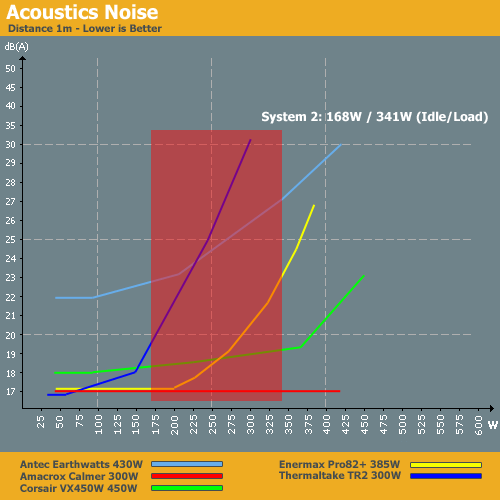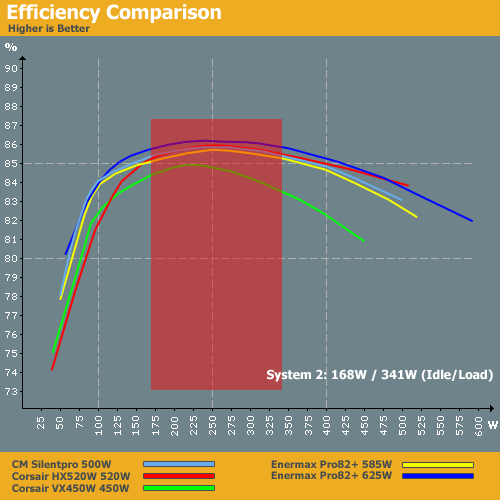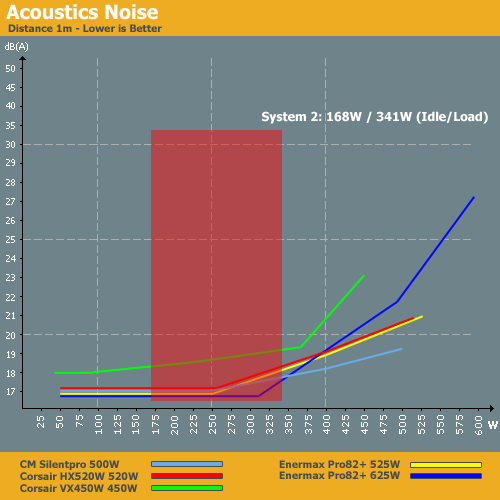Debunking Power Supply Myths
by Christoph Katzer on September 22, 2008 3:00 AM EST- Posted in
- Cases/Cooling/PSUs
PSUs for Midrange Systems
Our midrange system opens up a lot more in the way of potential power supplies, as there are far more manufacturers building 400W to 500W PSUs. Our idle power consumption in this case is 168W, which is quite high when compared to the 120W a high-end system would have used a few years back (i.e. AMD Athlon 64 4000+ and NVIDIA GeForce 7800 GTX under full load). However, times change and we see increased power requirements along with performance improvements.
Our selection of power supplies uses the same criteria as before. We will also see how our entry-level power supplies and all this sort of system.
- Cooler Master Silent Pro (500W) actively cooled
- Corsair HX520W (520W) actively cooled
- Corsair VX450W (450W) actively cooled
- Enermax Pro82+ (585W) actively cooled
- Enermax Pro82+ (625W) actively cooled


In terms of efficiency as well as the ability to supply sufficient power, all of the power supplies are able to run this midrange setup except for the 300W Thermaltake unit. The Antec Earthwatts has been around for a while, so it's not surprising that it doesn't perform as well as newer models, but it still delivers decent if not great efficiency. Noise levels are a different matter, and we would be inclined to avoid most of the entry-level PSUs. If noise isn't a consideration, all but the Antec will work; however, the Corsair VX450W performs best out of these units in so we will carry it along to the next level and include it with the midrange offerings.
Efficiency is Not the Issue

With the addition of some higher performing power supplies, efficiency clearly shouldn't be the overriding concern for a computer like our midrange system. The Corsair VX450W doesn't look as good in this graph, although 83% efficiency certainly isn't anything to cry about. The newer models all reach efficiency of around 85% to 86% throughout the midrange system load. Comparing the two scenarios, outside of PSUs that simply can't provide enough power it's not necessary to move up to a higher performance power supply. You want to look at other aspects such as features, warranty, and noise levels before making a decision.

In terms of noise levels, all of these units perform very well and can provide a quiet computing environment. We also see a clear separation between the entry-level PSUs in the midrange PSUs in this chart, since the midrange units are running a 75% load at worst. Again, if you've had the mindset that 600W and higher PSUs are required for modern midrange systems, the above charts should help dispel that myth. If you can find a good quality 400W PSU, it can easily power a midrange system. However, 500W PSUs generally make the best fit, as they provide optimal efficiency and lower noise.










98 Comments
View All Comments
kuraegomon - Monday, September 22, 2008 - link
Aargh. The most important argument for ensuring that your PS has plenty of headroom is ... lifespan!The most knowledgeable PS people out there will all tell you the same thing: running even a quality PS at consistently more than 80% or so of its rated output is all but guaranteed to reduce its operational lifespan. It's also a catch-22 because the longer a PS is run at high load, the less the maximum load it can support becomes. This isn't a terribly quick process, but quite a sure one. Track down any number of JonnyGuru's comments/reviews out there for more info.
Do all the math stated in this article, and figure out what your idle and load draws approximate too, then make sure you've got 30% headroom on top of your load requirement. This is BEFORE taking into account any expansion plans. Also, try to remember that 850 PCP&C supply described here STILL isn't being used the way a power user uses their system. It's spending more time at or near peak load, but it's also quite likely spending a fair bit of time on the shelf.
7Enigma - Monday, September 22, 2008 - link
What is your point? In the article the PSU's for each category are well under 80% utilization. If you look back at the charts, in the rated range for each system:-low end is utilized <50% of rated wattage
-mid-range is utilized <75% of rated wattage
-high-end is utilized <80% except for the Neopower Blue (which honestly looks pretty crappy both from a efficiency and sound standpoint)
That is across the board. In each category the higher-rated parts are obviously utilized less than those percentages.
Even the comments below each chart bares this out. For the low end, for example, they state that a 250w PSU would be perfect, while even a 200w would suffice. With a total system draw of 140w, the 250w would be near 50% utilization (56% if you want to be picky), and the 200w would still be <75% utilization.
I don't see fault in this article from that standpoint.
vlado08 - Monday, September 22, 2008 - link
The problem is that even if you calculate the expected power draw of your system you have to trust the label on the power supply and to be sure that if it says 500w then it is so. Well then you just end up to trust the trade mark or some reviews for the model you are going to by.Or you trust somebody who is going to assemble your new computer for you.
7Enigma - Monday, September 22, 2008 - link
Thank you very much for this article. As someone building a system by the new year I appreciate it greatly!One interesting thing is that there are times where the higher wattage supplies actually make more sense due to efficiency (and probably more connectors/warranty/etc.).
The Enermax Pro82+ 625w is definitely the best mid-range you have listed IMO for a stock system (ie non-OC'd), but for someone looking to OC their system I think the Zalman850 from the high-end section is probably the better buy (both efficiency and soundwise). There is a crossover point very close to idle power levels (if you take into account another 25-50w for an OC'd system), and so anything above idle will have better efficiency and at load quieter levels.
But I haven't checked the price difference, which I'm assuming is quite large. A 1-2% efficiency difference between the Enermax and Zalman is probably not worth the increase in price from both a ROI (from power savings and increased case temp from inefficiency).
Thanks again for the great review!
vlado08 - Monday, September 22, 2008 - link
In the article you didn't mention how did you measure the power draw of different components for example the CPU or the draw from PCI express? And haw did you test the efficiency of the different power supplies?Don Tonino - Monday, September 22, 2008 - link
I found the remarks concerning the efficiency charts a bit misleading... why give the range of efficiency of the high end system, for example, as between 85% and 89%, when the first number refers to the efficiency with 90VAC? the numbers given out are not consistent, as the systems at 230VAC show in reality the following efficiencies approx:low end - 74 to 80 %
midrange - 82 to 88 %
high end - 87.5 to 89.5%
Based on the numbers above, the PSU is actually quite well suited to the high system as the efficiency changes by a meager 2% between idle and load. It would be even better with some extra load, so to place the idle/load range between 450 and 700 W.
As far as the point to make is to show how efficiency changes with the load, it would have been as meaningful to give data just for the 230VAC, as it was already stated that efficiency with 120VAC or 90VAC would be even lower.
Insomniac - Monday, September 22, 2008 - link
The range isn't for 90VAC to 240VAC, it's to cover the idle load to full load range of the sample system.Don Tonino - Monday, September 22, 2008 - link
Check the chart. For every system the lower efficiency, the one given for the sistem at idle, has a value that at that particular power load (respectively given as 90W, 168W and 310W) lies on the red line, the one representing efficiency of the PSU when running at 90VAC.This is most evident if you take the high end system, which is stated will make the PSU run at an efficiency between 85% and 89%; those values, if you move on the blu line (PSU running at 230VAC) means a power load between 200W and 650W).
Giving the idle efficiency with the PSU running at 90VAC and the load efficiency with the PSU running at 230VAC gives a much higher change in efficiency than real. The only real meaning for it would be to say: "with such a system and such a PSU you will have an efficiency between A% and B%, based on the current the PSU is running on"... and I seriously doubt that anyone at home have an electrical system that changes VAC on the run.
Insomniac - Monday, September 22, 2008 - link
I see what you are saying now. I misunderstood what you said before. It seems a table would be better to show the efficiency range for each, or the values for one curve only (the article seems to say it was supposed to only be 230 VAC).JarredWalton - Monday, September 22, 2008 - link
Sorry for the error - not sure how we missed that, but yes the efficiency with the high-end system and UCP 900W is higher than stated initially. Must have been confused with the other systems, but I'll correct the text now.